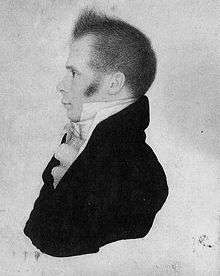George Watterston
George Watterston (23 October 1783 – 4 February 1854) was the third Librarian of the United States Congress from 1815 to 1829.
George Watterston | |
|---|---|
 | |
| 3rd Librarian of Congress | |
| In office 1815–1829 | |
| Preceded by | Patrick Magruder |
| Succeeded by | John Silva Meehan |
| Personal details | |
| Alma mater | Charlotte Hall Military Academy |
Biography
Watterston, the son of a builder from Jedburgh, Scotland, was born on board a ship in New York Harbor. When Watterston was eight, his family moved to Washington D.C., his father attracted by the ongoing construction in the capital. He graduated from the Charlotte Hall Military Academy.
Watterston became a lawyer, first practicing in Hagerstown, Maryland, later partnered with Thomas Law in Washington. He became a man of letters, publishing his first novel, The Lawyer, or Man As He Ought Not to Be, in 1808. He also published the novel Glencarn; or The Disappointments of Youth (1810); a play, The Child of Feeling (1809); and a poem, The Scenes of Youth (1813).[1] Many of his works contained unflattering portrayals of his profession. In 1813, he became editor of the Washington City Gazette.
During the War of 1812, Watterston participated in the failed defense of Washington D.C. The British burned the capital, including the Library of Congress, which was then housed in the Capitol building. After war's end, Watterston was appointed by President James Madison as Librarian of Congress, the third person to hold the position and the first with that as his sole responsibility. (Previous librarians also served as the clerk of the House of Representatives). The Library was replenished by purchasing the collection of former President Thomas Jefferson. Watterston gave the collection's books bookplates and labels and kept them organized according to Jefferson's basic classification scheme.[2]
Watterston was a Whig and active in politics. He opposed the election of President Andrew Jackson and upon Jackson's election was replaced. Watterston fruitlessly sought reinstatement for years.
After his dismissal, he became editor of the National Journal and published books on many subjects, including biographies and works on agriculture. He was instrumental in the campaign to construct the Washington Monument and was secretary of the Washington National Monument Society.
He was buried in the Congressional Cemetery in Washington, D.C.[3]
References
- Matheson, William (October 1975). "George Watterston: Advocate of the National Library". The Quarterly Journal of the Library of Congress. 32 (4): 370–388. JSTOR 29781654.
- Murray, S.A.P. (2012). The library: An illustrated history. New York: Skyhorse Publishing, pp. 163.
- Roberts, Rebecca Boggs; Sandra K. Schmidt (2012). Historic Congressional Cemetery, Images of America. Arcadia Publishing. p. 117. ISBN 9780738592244.
Additional sources
- John Y. Cole (30 March 2006). "Jefferson's Legacy: A Brief History of the Library of Congress -- Librarians of Congress". Library of Congress. Retrieved 2008-12-15.
